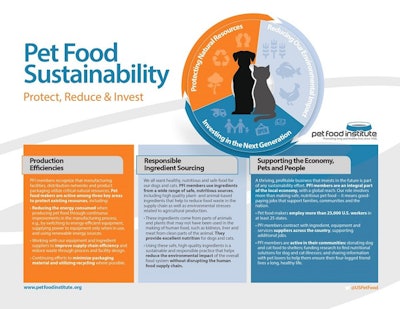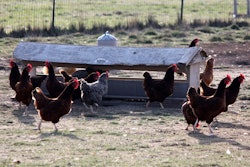
Sustainability concerns about the world’s food supply is nothing new for both the human and pet food industries. At Superzoo 2017, this was confirmed by claims appearing on new packaging. For example, many pet foods have already begun focusing on marine sustainability and seeking third-party approval by meeting requirements established by certain agencies to utilize their logos on their packaging.
Environmental impacts of food consumption by dogs and cats
A recent study out of the University of California Los Angeles (USA) has questioned the sustainability and environmental impact of the pet food industry along with dogs and cats (Okin, 2017). In particular, the research focuses on the impact of animal protein consumption by dogs and cats. Although the Okin study does bring more awareness of sustainability, it has many fundamental flaws.
Okin’s calculations were made on the following assumptions:
- Each of the first five ingredients contributes equally by percentage to the pet food.
- Together, the first five ingredients make up nearly all of the mass of the pet food on the market.
- The animal protein sources are all suitable for human consumption.
Incorrect assumptions = overestimation
Okin does acknowledge that the above assumptions are wrong and conservative; however, he proceeds anyway with his estimations of the environmental impact of dogs and cats.
Ultimately, Okin concludes that dogs and cats constitute approximately 25–30 percent of the environmental impacts from animal production in terms of the use of land, water, fossil fuel, phosphates and biocides. I think it is interesting that he backs off that 25-30 percentage in the discussion by starting to separate out the percentage of animal protein that would in reality be available for human consumption. When starting to take these factors into account, the numbers begin to reduce dramatically. However, these actual numbers are not captured in the abstract, research article or any of the news coverage (I wonder why?).
What is the impact if the ingredients go to the landfill?
With that being said, I do believe Okin has a valid argument for pet foods that use human-grade ingredients. However, for foods that do not utilize human-grade ingredients, Okin shrugs off the environmental impact of tossing these ingredients into landfills – likely because of his lack of knowledge of the pet food industry, which is clearly demonstrated in the assumptions he made for his calculations. I strongly believe Okin should have considered working with people in the industry or academia to determine or correct the flaws of his assumptions for real and more accurate calculations.
Pet food is sustainable today
For those of us in the pet food industry, we acknowledge that the animal protein sources we utilize are typically co-products of the human food industry that are not used for human consumption (e.g., kidneys, livers and meat from clean parts of the animal). By using these ingredients, the pet food industry has been practicing sustainability without impacting the human food supply for decades.
This practice of sustainability in pet food does not end with animal proteins. As an industry, we have been using co-products from other industries for decades, even those from plant-derived protein sources (e.g., soybean meal). Nevertheless, we can always look at new ways to continuously evolve, improve sustainability and reduce our environmental impact.
What good came from the study?
Although the study has many fatal flaws, it does allow our industry to look at ourselves and our companies and reflect on our impact on our environment. There are always ways to improve, whether it be in ingredient sourcing, manufacturing, corporate office practices or individual practices.
I would certainly be remiss if I didn’t mention a great review written by Kelly Swanson, PhD, of the University of Illinois, about sustainability of pet foods. This review covers many aspects of sustainability and would be a good starting point for sustainability within your organizations. It has open access online and is listed below under references.
Next topic: grain-free versus grains
Next time we will discuss this topic: “Grain-free isn’t better than grains.” If there are topics you would like to have discussed, feel free to comment below or reach out via LinkedIn: www.linkedin.com/in/ryanyamka.
References
Okin GS. 2017. Environmental impacts of food consumption by dogs and cats. PLoS ONE 12(8): e0181301. https://doi.org/10.1371/journal. pone.0181301
Swanson KS. 2013. Nutritional Sustainability of Pet Foods. Adv. Nutr. 4: 141–150.
Graphic at top of page: Pet Food Institute

















